Chess
Notes
Edward
Winter
When contacting
us
by e-mail, correspondents are asked to include
their name and full
postal address and, when providing
information, to quote exact book and magazine
sources. The word ‘chess’ needs to appear in the
subject-line or in the message itself.
6701. Early Reshevsky photograph
This particularly early photograph of Reshevsky, from
page 11 of Wiener Bilder, 30 September 1917, has
been submitted by Jan Kalendovský (Brno, Czech
Republic):
Mr Kalendovský also draws attention to a photograph
of Petrosian (signed by the master overleaf) in his
collection:
From Michael Clapham (Ipswich, England):
‘C.N. 6678 mentioned that the Alain White
Collection was housed in the South Africa National
Library. However, this is a collection not of A.C.
White’s own chess books but of about 500 volumes
compiled by Donald G. McIntyre and named after
A.C. White.
That information comes from the
Special
Collections section of the National Library of
South Africa website.’
Our correspondent asks what became of A.C. White’s own
chess book collection, which numbered ‘somewhat less
than 2,000 volumes’ in 1907, according to an article by
White on page 38 of the Chess Amateur, November
1907.
Wanted: substantiation of this ‘once’ quotation:
‘Alekhine once said, “There must be no reasoning
from past moves, only from the present position”.’
Source: The Golden Dozen by Irving Chernev
(Oxford, 1976), page 260.
Robert John McCrary (Columbia, SC, USA) writes:
‘My copy of Stamma’s The Noble Game of
Chess (London, 1745), which introduced the
algebraic notation to the West, has the bookplate
of the “Marquis Townshend”. I found that the first
Marquis was the brother of the man who authored
the “Townshend Acts”, which were among the sparks
that helped bring on the American Revolution. The
Marquis title was first conferred on the family
some years after 1745.
I wonder whether my copy belonged to that first
Marquis. His son, who inherited the title, was an
avid book collector.’
Among the subscribers to Philidor’s Analyse du
jeu des échecs was ‘M. Townshend’.
6706. A mate in three by Nimzowitsch
(C.N.s 6696 & 6700)
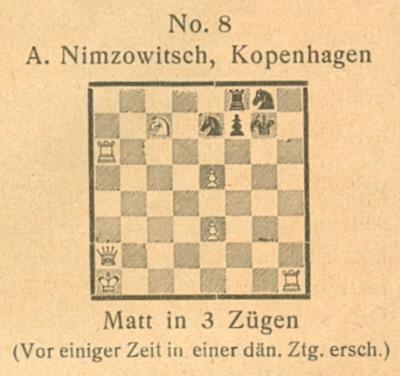
Kagans Neueste Schachnachrichten,
March 1932, page 70
From Peter Anderberg (Harmstorf, Germany):
‘The mate in three was published in Nimzowitsch’s
chess column on page 6 of the Baltische Zeitung
of 11 December 1918, in an article dealing with
smothered mate. (Note that the white king is on c1.)
A number of articles from Nimzowitsch’s column in
that publication were reprinted in my article “Aaron
Nimzowitsch und die Baltische Zeitung” in Kaissiber,
October-December 2007, pages 54-65.’
As an addition to Nimzowitsch the ‘Crown
Prince’ we note the following on pages 179-180 of
The 100 Best Chess Games of the 20th Century, Ranked
by Andrew Soltis (Jefferson, 2000):
‘Aron Nimzovich had an ego problem. After Carlsbad,
1929 he added a sign to his apartment door that read:
CANDIDATE FOR THE WORLD CHAMPIONSHIP. “So you won’t
forget?”, he was asked. “So that the chess world
doesn’t forget”, he replied.’
No source was offered.
6708. Nardus
Patrick Neslias (Esse, France) provides two photographs
of Léonardus Nardus
from his collection:
Léonardus Nardus (left)
and an unnamed opponent
Left to right: Frank
James Marshall, Léonardus Nardus,
Marie Gendreau (governess) and Pierre Boucherle
(painter and friend of Nardus)
Mr Neslias informs us that in October 2010 his book Butin
Nazi, dealing with Nardus’ final period in
Tunisia, will be published by Geste éditions.
6709. Additional pictures
We are grateful to Patrick Neslias (Esse, France) for
additional illustrations from his collection, including
two Marshall items and the ‘other’ Carlsbad, 1929 group
photograph (which was referred to in C.N. 5372):

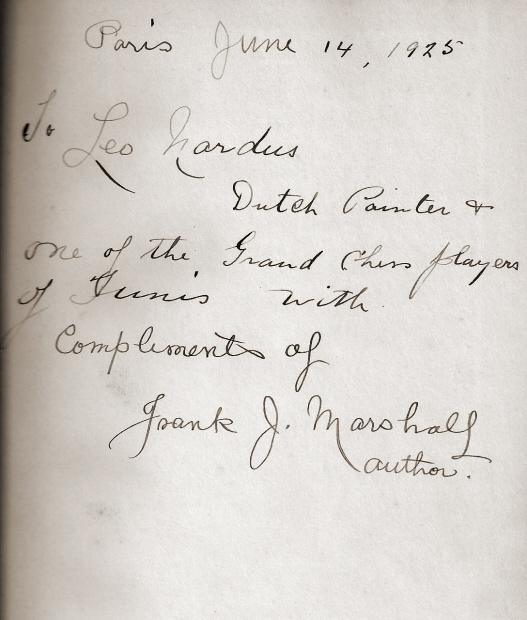

6710. Rubinstein in Brussels
Concerning Akiba
Rubinstein’s Later Years Martin Weissenberg
(Savyon, Israel) draws attention to a passage on page
123 of Histoire des maîtres belges by M. Wasnair
and M. Jadoul (1988):
‘Après la guerre, O’Kelly et Devos rendaient
régulièrement visite à Akiba Rubinstein qui avait
élu domicile à Bruxelles. Malade, absent, les yeux
éteints, le grand A. Rubinstein reprenait vie devant
l’échiquier. Comme le contait Devos, “ses yeux
s’allumaient sitôt l’échiquier installé”. Rubinstein
et O’Kelly ont joué ensemble des dizaines de parties
sur le même thème: 1 é4 é5 2 Cf3 Cc6 3 Fb5 Fç5 (le
système Cordel de la partie Espagnole). L’étude
approfondie de cette variante où O’Kelly conduisait
toujours les noirs, deviendra l’une de ses armes
favorites. L’enseignement des parties jouées avec A.
Rubinstein, mais surtout son travail personnel,
permettront à O’Kelly de passer du niveau de bon
maître national à celui de maître international et
enfin à celui de grand maître.’
Did either O’Kelly or Devos write any articles about
their meetings with Rubinstein?
John Blackstone (Las Vegas, NV, USA) notes that on
page 7 of the 16 December 1908 issue of the New York Evening
Post Emanuel Lasker gave a version of the
seventh match-game between Marshall and Mieses (played
in Berlin on 28 November 1908) which deviated from the
commonly-published score.
Lasker’s text was repeated on page 63 of the December
1908-January 1909 issue of Lasker’s Chess Magazine,
and for reasons of legibility that is the version
reproduced here:
The game-score as regularly presented elsewhere is
below (with, in square brackets, observations by Mr
Blackstone on the differences from Lasker’s version):
1 d4 d5 2 c4 e6 3 Nc3 c5 4 cxd5 exd5 5 Nf3 Nc6 6 g3
Be6 7 Bg2 Nf6 8 Bg5 Be7 9 dxc5 Qa5 10 O-O Qxc5 11 Rc1
O-O 12 e4 Qa5 13 Bxf6 Bxf6 14 exd5 Rad8 15 Qb3 Bxd5 16
Nxd5 Rxd5 17 Qxb7 Nd4 18 Nxd4 Rxd4 19 a3 Rd2 20 b4
Qxa3 21 Bd5 Bc3
22 Bxf7+ [‘22 Rb1 Rb2 23 Rxb2 Qxb2 24 b5 Qe2 25
Bxf7+ Kh8 is the line given by Lasker.’] 22...Kh8
23 Rb1 Rb2 24 Rxb2 Qxb2 25 b5 Qe2 [‘Now the lines
come back together.’] 26 Qxa7 Qxb5 27 Qe3
Qb4 28 Bd5 Bd4 29 Qe2 Qb2 30 Qxb2 Bxb2 31 Kg2 Rd8 32
Rb1 Rxd5 33 Rxb2 h5 34 f4 Kh7 35 Kh3 g5 36 Rb7+ Kg6 37
Rb6+ Kf5 [‘37...Kg7 38 Rb7+ Kg6 39 Rb6+ Kf5 40 Rh6
was given by Lasker.’] 38 Rh6 h4 39 Rh5 Kg6 40
Kg4 hxg3 41 hxg3 [‘This is where Lasker states
that Black resigned.’] 41…Kf6 42 Rxg5 Rxg5+ 43
fxg5+ Kg6 44 Kh4 Kg7 45 Kh5 Kh7 46 g6+ Kg7 47 Kg5 Kh8
48 Kh6 Resigns.
The 48-move version was given in various magazines of
the time, an example being Deutsches Wochenschach,
13 November 1908, pages 449-450. Even so, Lasker was
in Berlin at the time of the game. His column in the Evening
Post was headed ‘Berlin, 2 December’, and the
introductory text too was reproduced in Lasker’s
Chess Magazine (on page 40 of the
above-mentioned issue).
6712. Barden in the Evening
Standard
Leonard Barden (London) informs us that his daily
(Monday-Friday) chess column in the London Evening
Standard began in early June 1956. Apart from one
week in May 2009 when it appeared online only, the
column continued in the newspaper until 30 July 2010.
Since then, it has been published exclusively online.
Has there ever been, in any journalistic field, such a
run for a daily column by a single individual?
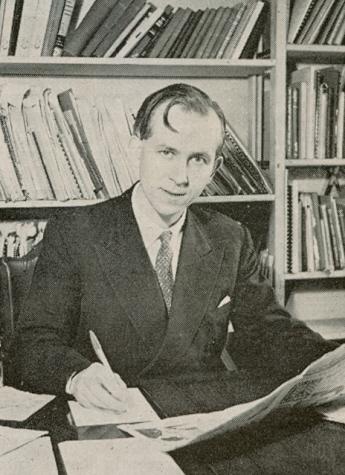
Leonard Barden (Chess
Life, August 1962, page 169)
Eduardo Bauzá Mercére (New York, NY, USA) sends the
third game in the Judd v Showalter match, as published
on page 5 of the New York Sun, 13 December
1891, and asks whether the score is correct. In
particular, do other sources explain Black’s
resignation or mention 38...Qxd6 and 40...Rd3 as
possibilities?
Max Judd – Jackson Whipps Showalter
Third match-game, St Louis, 10 December 1891
French Defence
1 e4 e6 2 d4 d5 3 Nc3 Bb4 4 Bd3 c5 5 Bb5+ Nc6 6 exd5
Qxd5 7 Nf3 Nf6 8 O-O Bxc3 9 bxc3 cxd4 10 Bxc6+ bxc6 11
cxd4 O-O 12 Re1 Nd7 13 Qd3 Rd8 14 Ng5 Nf8 15 Nf3 Ng6
16 c4 Qh5 17 Qe4 Rb8 18 Bf4 Nxf4 19 Qxf4 Ba6 20 Re5
Qg6 21 Rc1 Rb1 22 Ree1 Rxc1 23 Rxc1 Qd3 24 Qc7 Rf8 25
Qxc6 Qa3 26 Re1 Qxa2 27 Ne5 Bc8 28 d5 Qa5 29 Nf3 exd5
30 cxd5 Bg4 31 Rc1 h6 32 Rd1 Rc8 33 Qb7 Qa4 34 Rf1 Qf4
35 h3 Rb8 36 Qxa7 Bxf3 37 gxf3 Rb3 38 d6 Rxf3 39 d7
Qg5+ 40 Kh2 Resigns.
From page 1 of Lessons in Chess, Lessons in Life
by Jose A. Fadul (Morrisville and London, 2008):
‘Somebody complained that life is too short to be
wasted in trivial games such as chess. But William
Napier did retort that such is the fault of life,
and not of chess.’
The retort is indeed sometimes attributed to Napier
(for example, in a piece which appeared under Frank
Elley’s name on page 30 of Chess Life, March
1986), but we do not recall seeing it in Napier’s
writings.
As noted in The Most Famous Chess
Quotations, ‘Life’s too short for chess’ was a
line of dialogue in the play Our Boys by H.J.
Byron. Our feature article on Sir John Simon quoted from
page 116 of CHESS, 14 December 1937:
‘Deputizing for Sir John at the Sheffield Cutlers’
Feast recently, Dr Burgin, Minister of Transport,
referred to the Chancellor’s partiality to chess and
added, “Of chess it has been said that life is not
long enough for it – but that is the fault of life,
not of chess”.’
We commented that the longer quote is often attributed
to Irving Chernev, who gave it (without claiming
paternity) on page 108 of The Bright Side of Chess
(Philadelphia, 1948). Moreover, the book’s layout
created the false impression that Chernev was ascribing
the remark to Napier.
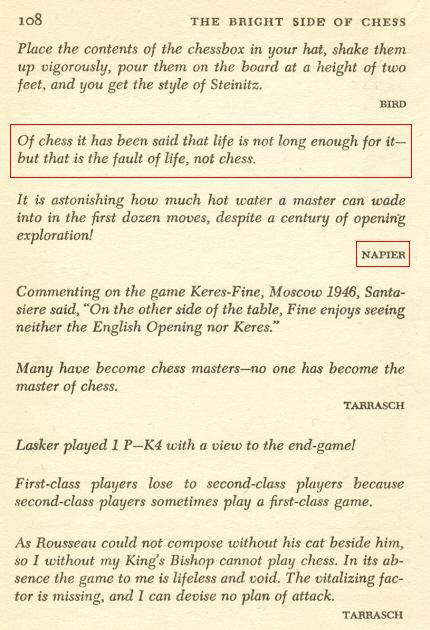
Another case of confusion arising from the layout of
quotes in that section of The Bright Side of Chess
is the ‘conferred sight’ remark attributed to Capablanca
(see C.N. 4209).
On page 313 of the October 1969 BCM D.J. Morgan
listed ‘Life is too short for chess, but that is the
fault of life, not chess’ as an unnamed reader’s entry
in a ‘Views on Chess’ competition. It was published on
page 30 of the Observer of 31 October 1937.
In the above-mentioned BCM item D.J. Morgan
stated that the winning entry in the 1937 Observer
competition was from Professor H.J. Rose:
‘Intimate conversation without a word spoken;
thrilling activity in quiescence; triumph and
defeat, hope and despondency, life and death, all
within sixty-four squares; poetry and science
reconciled; the ancient East at one with modern
Europe – that is Chess.’
This is relevant to the discussion of the quote, and
its author, in C.N. 5462.
A famous remark, it was reproduced on page 17 of The
Big Book of Chess by Eric Schiller (New York,
2006) with only two mistakes (‘quiescent’ and ‘poetry
and signs’).
6716.
Tom
Wiswell
Tom Wiswell has been mentioned in several C.N. items,
and now Gene Gnandt (Houston, TX, USA) draws our
attention to the checkers master’s appearance on an
edition of the television game-show What’s
My Line? broadcast on 21 February 1954
(starting at about 5’30” into the segment).
Robert Sherwood (E. Dummerston, VT, USA) points out
this photograph on page 23 of the February 1921 American
Chess Bulletin:
Justin Horton (Huesca, Spain) comments that many
Internet pages place Nimzowitsch’s alleged lament
about losing to ‘this idiot’ (Sämisch) not in Berlin,
as stated by Kmoch, but at Baden-Baden, 1925.
Half-way through that tournament Nimzowitsch did
indeed lose to Sämisch, but what evidence exists that
such an incident occurred there?
6719. Wendel v Nimzowitsch
Javier Asturiano Molina (Murcia, Spain) asks for
information about the exact occasion when the famous
game Wendel v Nimzowitsch (‘Stockholm, 1921’) was
played.
Nimzowitsch described it as ‘one of my best games’, and
it has been widely printed and praised. For instance, on
pages 6-8 of Irving Chernev’s The Golden Dozen
(Oxford, 1976) it appeared with the following
introduction:
‘There are deep, dark and mysterious moves in this
exotic game that could only have been produced by a
strange, original genius.’
The game was published (headed ‘Stockholm, 1921’, but
without further details) on pages 8-10 of the
January-February 1922 issue of the Swedish magazine Tidskrift
för Schack, with Nimzowitsch’s annotations:
Acknowledgement: Calle Erlandsson (Lund, Sweden) and
Peter Holmgren (Stockholm).
A different set of notes by Nimzowitsch appeared on
pages 148-150 of Kagans Neueste Schachnachrichten,
1 April 1925:
In the German magazine the heading stated that it was a
‘match game’. There was no such reference in a third set
of notes by Nimzowitsch, on pages 128-130 of his book Die
Praxis meines Systems (Berlin, 1930):
In none of these publications did Nimzowitsch identify
White by more than his surname, but the player is almost
certainly Verner Wendel (1893-1940), who has an entry in
Jeremy Gaige’s Chess Personalia. He was active
in Stockholm chess circles during the period in question
and participated in a tournament in that city, with
Nimzowitsch, in October-November 1920. From page 203 of
the November-December 1920 Tidskrift för Schack:
That same issue had Nimzowitsch’s notes to games by
Wendel against Olson and Spielmann, but neither of
Nimzowitsch’s victories against Wendel in the tournament
was given. Nor has any reference to a Nimzowitsch v
Wendel match been found in the Swedish magazine or
elsewhere.
It may thus be wondered whether the Wendel v
Nimzowitsch game under discussion was, in fact, played
in the Stockholm tournament of October-November 1920,
and not in 1921 as stated by Nimzowitsch. In that case,
though, Nimzowitsch could have been expected to publish
‘one of my best games’ in the Tidskrift för Schack of
the time, i.e. together with his wins against Olson,
Spielmann and Jacobson from the Stockholm, 1920
tournament (which he did annotate in the
November-December 1920 edition of the magazine).
However, as shown above, his notes to the Wendel v
Nimzowitsch game were not published until the
January-February 1922 issue.
If, therefore, the date 1921 for the Wendel v
Nimzowitsch game is correct after all, an event in which
it could have occurred remains to be identified.
6720. Alekhine quotation (C.N. 6704)
C.N. 6704 asked for substantiation of this quote
attributed to Alekhine: ‘There must be no reasoning from
past moves, only from the present position.’
Dan Scoones (Port Coquitlam, BC, Canada) refers to
comments by Alekhine in his 1938 radio interview (see
C.N. 5838): ‘Look forward all the time is the thing to
do.’ ... ‘I never look back on a game or a match but try
all the time to see how I may improve my play.’
From Dominique Thimognier (Fondettes, France) comes an
article ‘Ce que nous disait Alekhine!’ by Louis
Betbeder, which was published in a brochure for the 1967
French championship. One piece of advice by Alekhine (in
Betbeder’s reported speech and under the heading ‘Objectivité
du jugement’) was:
‘Savoir si l’on est mieux que l’adversaire est,
par conséquent, essentiel; se poser très souvent la
question, en particulier pendant qu’il réfléchit.
Juger surtout une position en oubliant complètement
l’histoire de la partie et en ne considérant que la
géographie, c’est-à-dire le diagramme actuel.’
Olimpiu G. Urcan (Singapore) mentions
that a better copy of the Reshevsky photograph can be
viewed in the Cleveland
Public Library Digital Gallery.
A question from Calle Erlandsson
(Lund, Sweden): are any photographs available of the
Scottish player Peter
Reid (1910-39)?
From page 109 of The Bright Side of Chess by
Irving Chernev (Philadelphia, 1948):
‘Nimzowitsch described someone as “An amateur who
played a weak enough game to enable him to conduct
an important chess column”.’
Chernev gave no further details, but the words
appeared on page 261 of Nimzowitsch’s book The
Praxis of My System (London, 1936). The
translation, by J. du Mont, omitted the name of the
columnist in question, but it had been given on page
180 of the original edition, Die Praxis meines
Systems (Berlin, 1930):
The name also appeared on page 154 of a recent
English translation (by Ian Adams) of Nimzowitsch’s
book, published under the title Chess Praxis
(Glasgow, 2007):
The report of Wilhelm Therkatz’s death on page 12 of
the January 1925 Wiener Schachzeitung stated
that he had conducted the chess column in the Krefelder
Zeitung for 26 years.
6724. Wood v Ritson Morry
Our Chess in the Courts
article quoted the following from page 161 of CHESS,
August 1954:
‘Chess Criminal Charge
B.H. Wood was acquitted at Birmingham Assizes on 14
July, without calling upon any evidence, of a charge
of criminal libel instituted by W. Ritson Morry. In a
letter to a Mr Golding, Mr Wood had indicated that if
Mr Morry was in the new Welsh Chess Union, Mr Wood was
out; he referred to Mr Morry as “this ex-gaolbird”. It
was held that Mr Wood was entitled to give his reasons
for withdrawing; that the description was true, as
Morry, after misappropriating clients’ money as a
Solicitor some years before, had been sentenced to 18
months’ imprisonment.
The Commissioner stated that in his opinion the case
should never have been brought, and awarded B.H. Wood
costs not exceeding £100.’
James Plaskett (Cartagena, Spain) asks whether further
details are available on Ritson Morry’s offence.
We note from Google
Books (snippets shown by a search for ‘Ritson
Morry’ and ‘solicitor’) that 1940s law reports had
information on the case. Could a reader with access to
the documents supply an account of the proceedings?
‘Every chess master was once a beginner’ is an
observation regularly credited to Irving Chernev.
Where did he write it?
Rick Kennedy (Columbus, OH, USA) is seeking more
information about a game which we reproduced in C.N.
2860 from page 79 of Beadle’s Dime Chess
Instructor by M.J. Hazeltine (New York, 1860):

Otho E. Michaelis – ‘Mr S.’
New York (date?)
(Remove White’s queen’s rook.)
1 e4 e5 2 Nf3 Bc5 3 Nxe5 Qe7 4 d4 Bb6 5 b3 d6 6 Ba3
Qd8 7 Nf3 Bg4 8 Bd3 d5 9 O-O Nf6 10 Re1 dxe4 11 Bxe4
Bxf3
12 Bc6 mate.
6727.
B. Niemzowitsch
C.N. 2273 (see page 26 of A Chess Omnibus)
asked for biographical information about the problemist
B. Niemzowitsch and gave this mate-in-three from page
587 of Die Schwalbe, November 1933:
We have received the following from Per Skjoldager
(Fredericia, Denmark), who, as mentioned in C.N. 3506,
is co-authoring with Jørn Erik Nielsen a book on Aron
Nimzowitsch:
‘Aron Nimzowitsch had three younger brothers, and
Benno (or Benjamin) was the youngest. He was born on
14 May 1896 (new style) and by the first of his two
marriages he had a son, Isay-Erik (born in Berlin on
28 July 1928). Benno lived in Berlin for several
years, before moving to Langfuhr, Danzig. He was a
strong chessplayer as a boy but put his efforts into
problem composition. Because of his Jewish
background, he had to flee from the Nazis, and he
finally went back to Riga. The Nazis killed the
entire family in 1941.
Benno Niemzowitsch
(photograph courtesy of Per Skjoldager)
In our collection we have more than 30 problems by
Benno Niemzowitsch. For the most part they are
self-mate compositions, but there are also a few
direct-mate problems. His first composition on
record was published in the Baltische Zeitung
of 2 October 1918, in Aron Nimzowitsch’s chess
column (“Erstabdruck”):
Mate in four
When this problem was given on page 95 of Skakbladet,
June 1936 the pawn on g7 was missing, and the
composition was ascribed to Aron Nimzowitsch.’
Mr Skjoldager informs us that the Nimzowitsch book
mentioned in the previous item is due to be published
in 2011 and he adds:
‘An early game between Benjamin Blumenfeld and
Aron Nimzowitsch, Berlin, 1903 (1 e4 e5 2 Nf3 Nc6
3 d4 exd4 4 Nxd4 Nf6 5 Nxc6 bxc6 6 Bd3 d5 7 e5 Ng4
8 O-O Qh4 9 h3 h5 10 Bf4 Bc5 11 Qd2 Rb8 12 Nc3 Rb4
13 Bg5 Qg3 14 hxg4 hxg4 15 Rfe1 Rh2 16 Bf1 Rh8 17
Bd3 Rh2 18 Bf1 Bxf2+ 19 Qxf2 Rh1+ 20 Kxh1 Qxf2 21
Re2 Qg3 22 Rd1 Bf5 23 Nxd5 cxd5 24 Rxd5 Rb8 25 e6
fxe6 26 Rxf5 Kd7 27 Rf7+ Kc6 28 Rxe6+ Kb7 29 Kg1
Resigns) can be found on the Internet, but we have
not been able to trace a source for it.
We believe that it is probably a “real game”,
partly because Nimzowitsch played this particular
variation of the Scotch Game in his youth and
partly because he was acquainted with Blumenfeld
during his early years in Berlin. We have looked
through all possible chess columns and all
contemporary German periodicals, as well as
Blumenfeld’s books, without success, but the game
may have been published by him in a Russian/Soviet
chess magazine. Can anyone find it?’
6729. Caroline Marshall letter
Patrick Neslias (Esse, France) provides from his
collection a letter sent by Caroline Marshall to
Léonardus Nardus announcing her husband’s death:
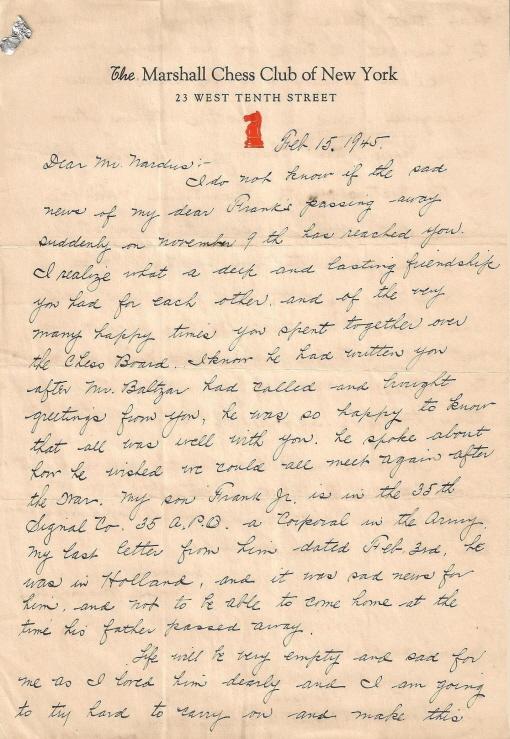
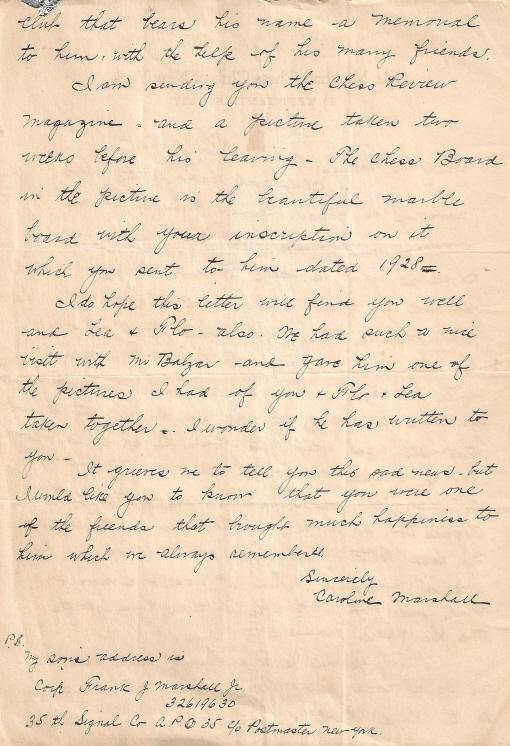
Below is the photograph referred to by Mrs Marshall,
reproduced from page 2 of the December 1944 Chess
Review:
Further to our feature article on E.M. Antoniadi,
Dominique Thimognier (Fondettes, France) has submitted
three games published in Les tablettes du chercheur
in 1894 (pages 162, 176, 194 and 195):
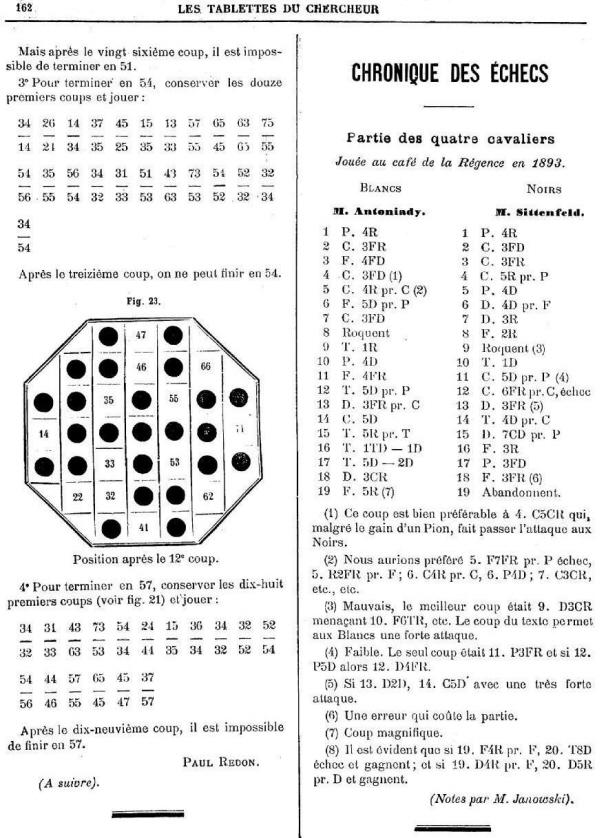
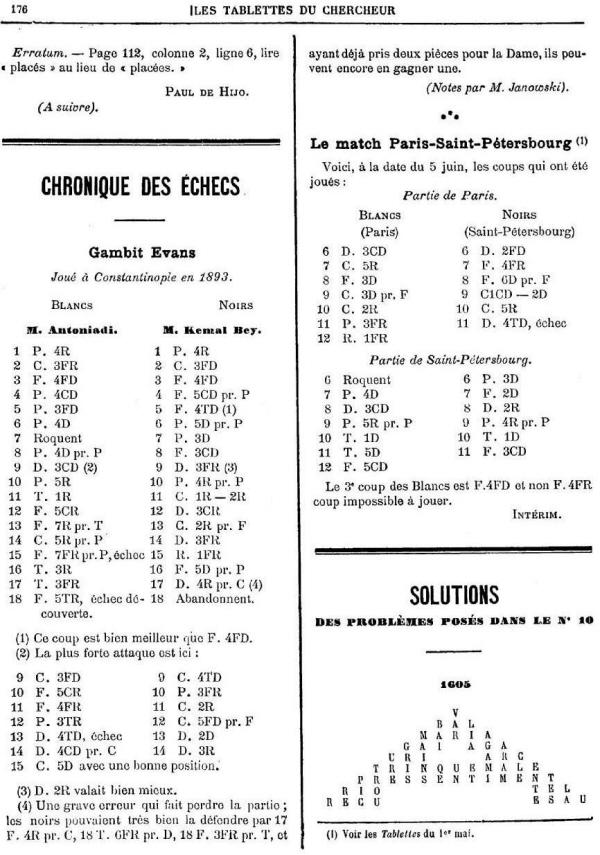

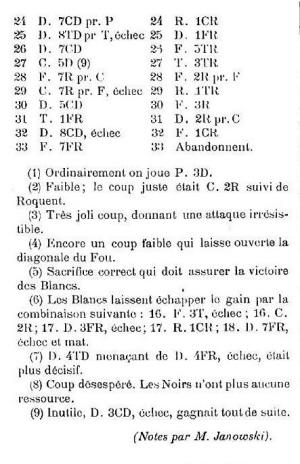
6731. Lasker problem
Jan Kalendovský (Brno, Czech Republic) sends a
straightforward problem (mate in three) composed by
Emanuel Lasker for young solvers which was published on
page 32 of the Neue Freie Presse, 22 December
1935:
A serious disservice is done to chess history by some
‘modern’ editions of old tournament books. The latest
example is London 1922 by G. Maróczy (Milford,
2010), which not only discards the original book’s
introductory material but brushes out the editor and
publisher, W.H. Watts, and a master, Amos Burn, who
annotated at least 18 of the games.
In the original edition, games featuring Burn’s
annotations (games 41-44, for example) ended with the
specific reference ‘Notes from The Field’:
On page 5 of the original edition Watts gave an
explanation indicating that the total number of games
annotated by Burn, as opposed to Maróczy, might well
be even higher than 18:

David McAlister (Hillsborough, Northern Ireland)
inform us:
‘There are a number of Law Reports on the
criminal proceedings brought against Ritson Morry.
However, they all report not the trial itself but
his unsuccessful appeal against conviction heard
by the Court of Criminal Appeal on 29 October
1945. His grounds of appeal were essentially
concerned with legal technicalities, and the
judgment of the three-judge Court of Criminal
Appeal (delivered by Mr Justice Hilbery) does not
go into details about the criminal charges which
Morry faced. It merely states:
“At the summer assizes at Birmingham, on 26 July
1945, the appellant was tried on an indictment
containing four counts charging him with
fraudulent conversion of four sums of money
totalling £3,136. He was convicted on all counts,
and sentenced to 18 months’ imprisonment.”
This passage appears on page 633 of Volume 2 of the
All England Reports for 1945. The complete
report is on pages 632-636 and was cited by lawyers
as R. v Morry [1945] 2 All ER 632.’
6734.
Young masters
From page 168 of the July-August 1931 Kagans
Neueste Schachnachrichten:
Dominique Thimognier (Fondettes, France) has found an
article by Louis Mandy on pages 51-52 of the May-June
1955 issue of L’Echiquier de Paris. Entitled ‘La
Rennaissance Echiquéenne’, it discussed the
chess magazine of that name, which was edited by
Gesztesi/Gestesi during its brief run (March-July
1912).
Mandy’s article included some biographical
information about him and this picture, a detail from
a photograph taken during a simultaneous exhibition in
Sceaux on 24 November 1911:
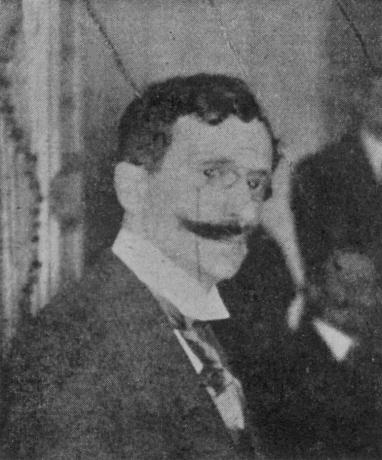
Paul Timson (Whalley, England) provides further
details:
‘As mentioned by David McAlister in C.N. 6733,
the only references to Ritson Morry in the Law
Reports relate to a decision of the Court of
Criminal Appeal on 29 October 1945, before
Hilbery, Wrottesley and Stable, the appeal being
based on technical legal grounds. I offer a
summary below.
At the summer assizes at Birmingham on 25-26
July 1945 the appellant, William Ritson Morry, a
solicitor, was tried on an indictment containing
four counts charging him with fraudulent
conversion of four sums of money totalling £3,136.
He was convicted on all counts and sentenced to 18
months’ imprisonment.
He appealed against his conviction on a number
of technical legal grounds and represented himself
at the Court of Criminal Appeal.
One of the grounds of appeal was that when he
was committed for trial by the magistrates’ court
the magistrates, as they were obliged to do, asked
him the question laid down by statute: “Do you
wish to say anything in answer to the charge? You
are not obliged to say anything unless you desire
to do so, but whatever you say will be taken down
in writing and may be given in evidence upon your
trial.”
In response to that question he took the
opportunity to make a speech, lasting some three
hours, as an advocate on his own behalf. He now
appealed on the grounds that because every word of
his speech was not taken down and certified, the
committal was irregular and the whole indictment
should have been quashed.
The Court of Criminal Appeal held that the
procedure of calling upon the accused to make a
statement if he chooses at that stage in the
proceedings, where the magistrates are considering
whether or not a case is made out for committal,
was never intended to apply to a man making an
oration as an advocate on his own behalf. They
therefore dismissed this ground of appeal.
Another ground of appeal was that the
magistrates had refused to commit him for trial on
the charges which were the subject of counts one
and two in the indictment. The trial judge had,
however, decided that these counts should be
included in the trial, as well as counts three and
four (on which the magistrates had committed him),
and the appellant was duly convicted on all four
counts.
The Court of Criminal Appeal held that this was
a matter for the trial judge to decide, and his
decision could not be questioned.
The appeal was therefore dismissed, and the
Court held that the sentence of 18 months’
imprisonment would run from the date of
conviction, namely from the first day of the
assizes (25 July 1945).
The Wood v Ritson Morry case was reported in the
Times newspaper on 7 April 1954, when B.H.
Wood was committed for trial, and on 15 July 1954,
when he was acquitted on the charge of criminal
libel.
The offending paragraph of Wood’s letter to
Henry Golding, dated 23 February 1954, was quoted
by the Times:
“Your whole attitude makes it clear that you are
a Morry stooge. When you have become in due time
disillusioned about this ex-gaolbird and have
returned to sanity please contact me again unless
you are so fed up that you drop out of chess
altogether as some have done.”
The 7 April 1954 report in the Times
stated:
“Mr Morry said that at one time he practised at
Sutton as a solicitor. ‘I fell on evil times,
however, and was sentenced to 18 months’
imprisonment for fraudulent conversion, which I
served and returned to public life’, he said. He
had put himself at right with the world and was
entitled to live at peace with it. The use of the
expression ‘ex-gaolbird’ with its highly
defamatory meaning was in itself sufficient to
maintain a conviction for criminal libel,
submitted Mr Morry.”
That report also quoted two officials of the
British Chess Federation, Sir Leonard Swinnerton
Dyer and George Wheatcroft, as stating that they
were aware of Morry’s past conviction but had had
no objection to his holding office in the
Federation.
From personal knowledge I can give a fuller
answer to James Plaskett’s question in C.N. 6724.
I studied law at Birmingham University from 1965
to 1968 and whilst there I played in the
Birmingham chess league at a time when B.H. Wood
and W. Ritson Morry (both also graduates of
Birmingham University) were still playing in the
league. I had several long conversations with
Wood, who was President of the University Chess
Club and, as I recall, it was he who told me the
story of Ritson Morry’s downfall. In the late
1930s Ritson Morry, who was a solicitor, invested
clients’ money without their knowledge or consent
in a speculative property development. He was
convinced that the development would make a large
profit and he would be able to replace the
clients’ money and take the profit for himself.
Unfortunately for Ritson Morry, with the outbreak
of the Second World War the development collapsed
and he lost all the money which had been invested.
As he was unable to replace his clients’ money
from his own resources, they reported the matter
to the police as soon as they became aware of the
situation, and this resulted in his eventual
conviction and imprisonment, and also in his being
struck off the roll of solicitors.
He did eventually repay the money.’
The photograph below (showing the English players who
went to Holland to play a Dutch team) comes from page
296 of the June 1937 BCM:
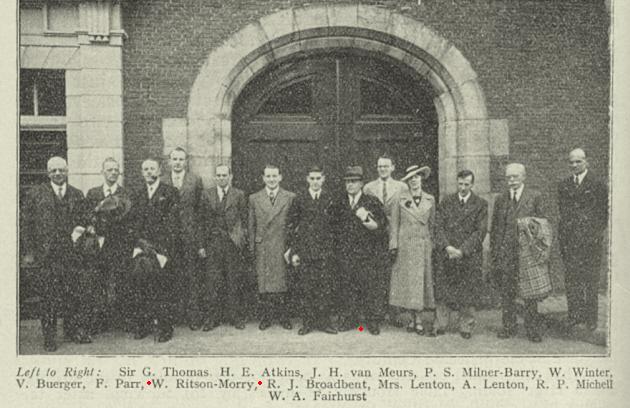
6737. Wendel v Nimzowitsch (C.N. 6719)
C.N. 6719 asked whether the Wendel v Nimzowitsch game
under discussion (which began 1 e4 Nc6 2 d4 d5) was
perhaps played in the double-round tournament in
Stockholm, October-November 1920.
Maurice Carter (Fairborn, OH, USA), who has a book on
Nimzowitsch in progress, informs us that that
possibility can be discounted, given that he owns
Nimzowitsch’s score-sheet of the game against Wendel in
which Nimzowitsch was Black. The heading provided by our
correspondent is shown below:
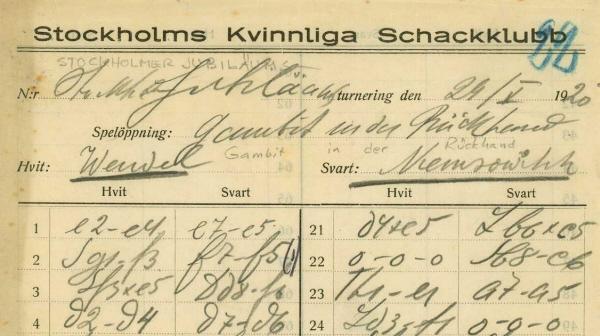
From pages 222-223 of ‘Garry Kasparov on My Great
Predecessors Part I with the participation of
Dmitry Plisetsky’ (London, 2003):
‘To the super-tournament in New York (1927),
arranged to “accommodate” Capablanca, Lasker was no
longer invited.’
Zenón Franco Ocampos (Ponteareas, Spain) asks whether
this is true. The answer is no, because Lasker was
invited to New York, 1927.
We discussed the matter on pages 195-197 of our book
on Capablanca, referring to the bitter public dispute
which had arisen at New York, 1924 between Lasker and
Norbert Lederer (the latter being a key figure on the
organizing committees of New York, 1924 and New York,
1927).
Much additional information was presented in the
article ‘New York 1927 Documentary Evidence Answers
Lingering Questions’ by Hanon Russell on pages 88-104
of the first issue of the American Chess Journal
(1992). A section of the article (pages 99-101) was
headed ‘Why Didn’t Lasker Play?’, and it showed that
although the New York, 1927 organizing committee did
not believe that Lasker would participate, Lederer ...
‘... made an extraordinary effort to convince
Lasker to play. He enlisted the help of influential
people in the United States and Europe, but Lasker
was not persuaded. Finally, as the plans which were
formulated had to be finalized, Lederer made one
last effort. On 10 December 1926 he wrote a
five-page typewritten letter in German to Lasker
(Russell Collection #584). Lederer, whose first
language was German (he was born in Vienna), wanted
to make absolutely certain that he would not be
misunderstood. Lederer’s formal invitation to Lasker
specified all the terms, financial and otherwise,
being offered to Lasker as well as a strong plea for
Lasker to relent and play in what was recognized
even then as one of the world’s great chess
tournaments.’
Lasker refused the invitation.
See also pages 74 and 640 of Emanuel Lasker:
Denker Weltenbürger Schachweltmeister edited by
R. Forster, S. Hansen and M. Negele (Berlin, 2009).
Richard J. Hervert (Aberdeen, MD, USA) and Alan
McGowan (Waterloo, Canada) comment that the caption in
Kagans Neueste Schachnachrichten is faulty,
since Pirc is standing second from the right. (A
photograph of the young Pirc was given in C.N. 6131.)
On the subject of photographs from Kagans Neueste
Schachnachrichten, the following appeared on
page 56 of the March 1932 edition:
Daniël Noteboom
Page 48 of the February 1932 issue stated that the
photograph had been given to Kagan by Euwe.
6740. Morphy at the Opera
Regarding the game Morphy
v the Duke and Count and the correct spelling of
the Count’s name, Kevin O’Connell (Mouret, France)
informs us:
‘1. Vauvenargues (Vauvenarga or Vauvenargo in the
Provençal language, which was still dominant in the
area in the 1870s) is a village in Provence.
Vauvenargues is the French version, but the village
is located in Occitania and so has its Occitan name,
but there are six dialects, of which Provençal is
one. Within Provençal there are two orthographical
norms, one of which gives “Vauvenargo” and the other
“Vauvenarga”. The latter would almost certainly be
favoured today.
2. The château, bought by Picasso in 1958,
belonged to the Isoard family from 1790 to 1943.
Information is available under “Histoire et
patrimoine” at the website of the Mairie de
Vauvenargues.
3. In all variants of Occitan (including
Provençal) “o” is invariably pronounced “ou” unless
it has a grave accent (ò), in which case it should
be pronounced like the “o” in Opéra.
4. In spelling the Count’s name today, there is
certainly some latitude, but I suppose that it
should officially be Comte Isoard de Vauvenargues,
in recognition of the considerable success of the
French authorities (during the approximate period
1870-1930) in almost stamping out the language of
the people of the southern half of France, even
though it is 99% certain that his name was
pronounced “Isouard”.’
Pages 14-15 of 100 Classics of the Chessboard
by A.S.M. Dickins and H. Ebert (Oxford, 1983) gave
Alekhine v Sämisch, Berlin, 1923 under the heading
‘The Classic Blindfold Game’. The co-authors claimed:
‘Happening to meet in Berlin, the two players
decided to take the opportunity of playing each
other blindfold, creating as a result this
astonishing brilliancy.’
The book added that Sämisch called Alekhine’s victory
‘the most brilliant game I have ever seen’. The moves:
1 e4 c5 2 Nf3 Nc6 3 Be2 e6 4 O-O d6 5 d4 cxd4 6 Nxd4
Nf6 7 Bf3 Ne5 8 c4 Nxf3+ 9 Qxf3 Be7 10 Nc3 O-O 11 b3
Nd7 12 Bb2 Bf6 13 Rad1 a6 14 Qg3 Qc7 15 Kh1 Rd8 16 f4
b6 17 f5 Be5 18 fxe6 Bxg3 19 exf7+ Kh8 20 Nd5 Resigns.
It is one of Alekhine’s most spectacular miniatures,
number 97 in his first collection of Best Games (London,
1927). The heading was ‘Exhibition Game played at
Berlin, February 1923’. The book did not suggest that
either master was blindfold. Nor did the German
translation, Meine besten Partien 1908-1923
(Berlin and Leipzig, 1929), although we have one later
edition in German (Berlin, 1983), which states ‘Beiderseits
ohne Ansicht des Brettes’. Various editions of
the book Meisterspiele by Rudolf Teschner say
that both players were without sight of the board, and
Sämisch’s praise of Alekhine is quoted:
‘“Die genialste Partie, die ich je gesehen
habe”, äußerte Sämisch voll Bewunderung für seinen
Gegner.’
As shown below, Tartakower cited Sämisch when he
published the game (a ‘Gastkampf’ , which
Tartakower dated 1921, instead of 1923, with no
intimation of blindfold play but with an additional
move at the end) on page 276 of Die hypermoderne
Schachpartie (Vienna, 1924):
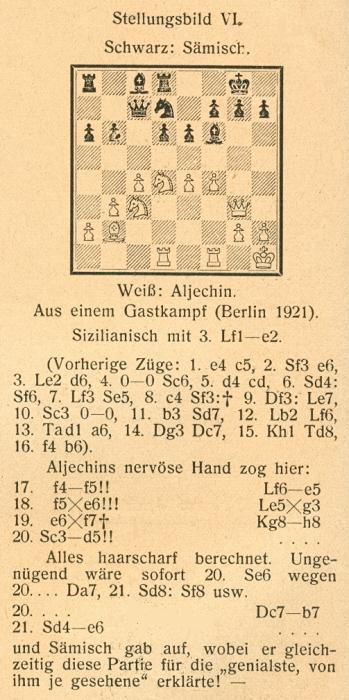
January, rather than February, 1923 was specified
when the game appeared on pages 218-219 of the second
volume of Complete Games of Alekhine by V.
Fiala and J. Kalendovský (Olomouc, 1996). The
co-authors asserted that the game was first published
on page 16 of the Observer, 4 March 1923. In
neither that volume nor in the Skinner/Verhoeven book
on Alekhine (see page 184) was it suggested that
Alekhine or Sämisch played the game blindfold.
Moreover, the score was not included in Blindfold
Chess by E. Hearst and J. Knott (Jefferson,
2009).
The brilliancy is absent from all the chess magazines
of 1923 that we have consulted so far.
6742. William Hartston in Now!
Throughout the run of the weekly news magazine Now!
(September 1979-April 1981) there was a fine chess
column by William Hartston. Some quotes are offered
below:
- ‘... combinations are much easier to find if you
know they are there. If only those magic words “White
to play and win” would light up below the board, we
would all win so many more games. In real life most of
the sacrifices are not correct; only the fantasy world
of the chess columnist has flashy finishes to games
...
Some years ago I was playing in the Hastings
tournament with Mikhail Tal. One evening, he picked up
an English newspaper, casually glanced at the chess
column and started laughing. What had attracted his
attention was the position given for readers to solve:
it was from his own game against Platonov played at
Dubna in 1973.
The amusement, however, was caused by the set of par
solving times appended in order to rate one’s
achievement in finding the answer. These began at 20
seconds, indicating grandmaster strength, then
proceeded via master, county player and club player to
stop at “average” – five minutes. “That’s very funny”,
said Tal. “I spent 15 minutes looking at the position
before I saw it, and my opponent didn’t see it at
all.”’ (4-10 January 1980, page 98.)
The position in question was given:

White (Tal) to move
- ‘You can tell a great deal about a chessplayer by
the way he looks at the board when it is his turn to
move. Spassky always wears the bored expression of a
man in a bus queue, in no particular hurry. Korchnoi,
on the other hand, looks as though he is in danger of
missing his train, while Karpov has the confident pose
of one who knows that the train will wait for him even
if he is late. But this week, we shall be talking
about Polugayevsky. He looks as though he is the only
one with a timetable, cannot understand why the bus
was not there ten minutes ago, and is about to panic
and run for a taxi.’ (11-17 July 1980, page 88.)
- ‘Modern grandmasters, of course, are far superior in
technique and understanding, but games from the
distant past have a feeling of spontaneous enjoyment
and a quest for brilliance which is generally lacking
in today’s sophisticated world. ...
Such a game as this [the famous Steinitz Gambit
brilliancy won by Robert Steel from the 1880s] gives
the impression that calculating ability and
imagination in chess are no better now than they were
100 years ago. The game is far more scientific, of
course, but for sheer flair and inventiveness such
nineteenth-century brilliancies remain practically
unparalleled in modern play.’ (25-31 July 1980, page
88.)
- ‘I met the eponymous professor [Arpad E. Elo] during
the chess olympics at Nice in 1974. He was besieged
with requests by players wanting the rules bent to
accommodate their own requests for international
titles. When the last of the supplicants had gone,
Professor Elo said to me: “I think I have created a
monster.” I think so too.’ (1-7 August 1980, page 82.)
- ‘Even when games are annotated by the players
themselves, most fall victim to the temptation to
justify their decisions rather than explain them.
Chess is not a precise science or even a totally
logical game. Only after the result is decided do the
annotators feel obliged to present the decisions in
black and white. ...
All the more enjoyable therefore to come across the
rare example of totally honest annotators of their own
games. Of today’s great players I put complete trust
in Larsen and Tal.’ (8-14 August 1980, page 82.)
- ‘One reason for the wide appeal of chess lies in the
ambiguous nature of the game. Some claim it is a
sport, others view it as a science while many try to
elevate chess to the level of art. I have always taken
the view that chess is primarily a sport masquerading
as a minor art form.’ (3-9 October 1980, page 80.)
- ‘Some time ago the great Russian player David
Bronstein gave me this advice: “Look at the games of
Gordon Crown. He really understood chess”.’ (6-12
February 1981, page 80.)
6743. Michaelis gamelet (C.N.s 2860
& 6726)
John Hilbert (Amherst, NY, USA) notes that the gamelet
was published in the New York Clipper, 8
September 1860, introduced as follows:
‘An exceedingly curious mate given by our contributor
Otho E. Michaelis giving QR.’
From Eduardo Bauzá Mercére (New York, NY, USA) comes
a report on page A10 of the Brooklyn Daily Eagle,
16 May 1929:
‘Lasker-Lederer Settlement
The judiciary committee of the National Chess
Federation, of which Judge Jacob E. Dittus of
Chicago is chairman, has adjudicated the controversy
between Dr Emanuel Lasker of Berlin, former world’s
champion and winner of first prize in the
international masters’ tournament in New York, 1924,
and Dr Norbert L. Lederer, director of that
tournament, according to advices received from
Chicago.
Dr Lederer had lodged a formal complaint against Dr
Lasker with the committee to the effect that Dr
Lasker had published statements reflecting upon his
character, as well as upon the executive committee
of that tournament, and which, he declared, called
for an apology. Dr Lasker, it is said, agreed to
abide by the findings of the judiciary committee.
The committee decided that Dr Lederer’s complaint
was justified and that the facts in the case did not
bear out Dr Lasker’s accusation. A report of the
findings was sent to Dr Lasker.
Edward Lasker, recently elected secretary of the
National Chess Federation, said yesterday that he
and other friends of Dr Emanuel Lasker felt certain
that the latter will acquit himself gracefully by
publicly retracting his charges. Dr Lasker became 60
years of age on 24 December last, an occasion which
was fittingly celebrated by the chessplayers of
Germany.’
John Blackstone (Las Vegas, NV, USA) refers to a game
given in databases as won by Emanuel Lasker (White) in
a simultaneous exhibition in the Netherlands in 1908
against C.A. Moller:
1 e4 e5 2 Nf3 Nc6 3 Bc4 Nf6 4 d3 Bc5 5 Nc3 d6 6 Be3
Bb6 7 Qd2 O-O 8 O-O Be6 9 Nd5 Bxd5 10 exd5 Ne7 11 Bg5
Ng6 12 Nh4 Nxh4 13 Bxh4 Ne4 14 dxe4 Qxh4 15 Bd3 g6 16
Kh1 f5 17 g3 Qf6 18 f3 f4 19 g4 Rf7 20 Rae1 Qh4 21 Re2
g5 22 Rg2 Kg7 23 c4
23...Rd8 24 b4 Bd4 25 Qc2 b6 26 a4 Kf6 27 Qe2 h5 28
Rc1 Rh7 29 Rc2 Qh3 30 Ra2 Bc3 31 b5 hxg4 32 Rxg4 Be1
33 Rg2 Bg3 34 Rd2 Bxh2 35 Rxh2 Qg3 ‘1-0’.
Noting that the game was given in Lasker’s column on
page 7 of the New York Evening Post, 1 August
1908 as played in Copenhagen at 15 moves an hour, with
Lasker as Black against C.A. Möller, our correspondent
asks, ‘Do you know the truth?’
This is a further example of the unreliability of
databases. The game as given in the Evening Post
also appeared on pages 99-100 of Lasker’s Chess
Magazine, September 1908. Lasker won as Black,
and the game, played in Copenhagen, did not occur in a
simultaneous display.
Moreover, both the newspaper and the magazine had
Black’s 23rd move as ‘QR-R’, i.e. 23...Rh8 and not
23...Rd8 as given in the databases. With 23...Rh8 the
game’s conclusion makes sense.
Chess Notes Archives
Copyright: Edward Winter. All
rights reserved.
|